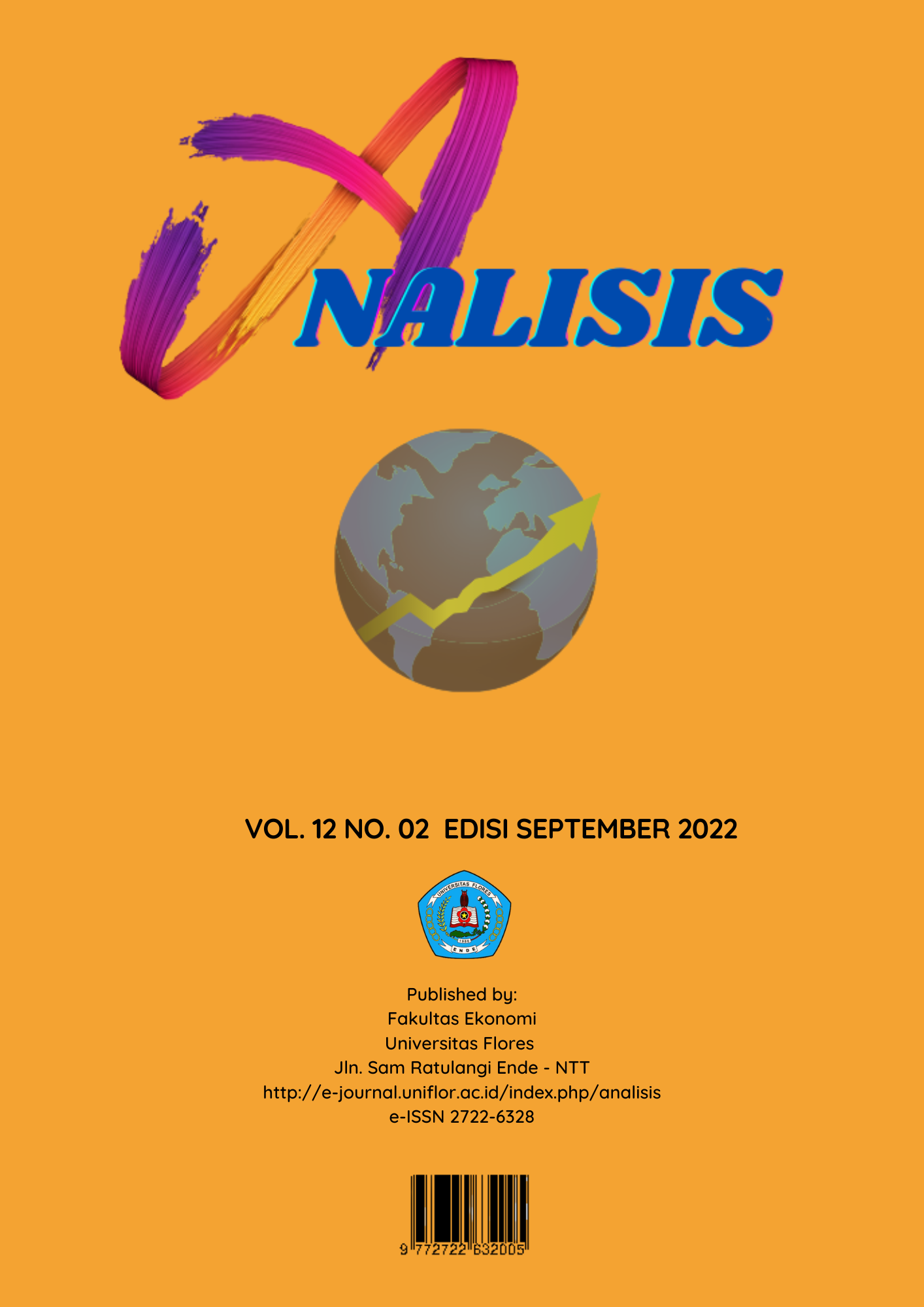PERAN LEMBAGA KEUANGAN MIKRO DAN TENAGA KERJA TERHADAP PERTUMBUHAN EKONOMI
DOI:
https://doi.org/10.37478/als.v12i2.1757Abstract
Economic growth is a measure of the welfare of the Indonesian people. Over time, the factors that affect economic growth are growing. The emergence of Microfinance Institutions (MFIs) has its own impact on Indonesia's economic growth. This study aims to determine the effect of Microfinance Institutions on economic growth in Indonesia. By using the Random Effect Model (REM) panel data regression method covering 21 provinces in Indonesia in the 2019-2020 period, this study shows that, only the Labor variable is proven to have an effect on economic growth in Indonesia. While the variables for the number of MFIs and the amount of MSME loan funds have not been proven to have an effect on economic growth in Indonesia. This indicates that the human resource factor as a form of human capital is the main factor driving economic growth in Indonesia. So that the policy implication of this research is to encourage economic growth a policy to improve the quality of human resources is needed.
Keywords: Economic Growth, Total Microfinance, Labor, REM
Downloads
Keywords:
Economic Growth, total microfinance, Labor, REMReferences
Agustin, A. F. (2011). Peran Lembaga Keuangan Mikro (Lkm) Terhadap Kinerja Ekonomi Kabupaten Jombang. Jurnal Ekonomi Pembangunan, 9(2), 225. https://doi.org/10.22219/jep.v9i2.3676
Alimukhamedova, N. (2014). Contribution of Microfinance to Economic Growth: Transmission Channel and The Ways to Test It. Business and Economic Horizons, 9(4), 27–43. https://doi.org/10.15208/beh.2013.20
Dash, D. P., & Sethi, N. (2022). Pandemics, Lockdown and Economic Growth: a Region-Specific Perspective on Covid-19. Buletin Ekonomi Moneter Dan Perbankan, 25, 43–60. https://doi.org/10.21098/bemp.v25i0.1841
Insani, R. N., & Indra. (2015). Analisis Faktor-Faktor yang Memengaruhi Tingkat Pertumbuhan Ekonomi pada 20 Negara OKI Tahun 2009-2013. Muqtasid: Jurnal Ekonomi Dan Perbankan Syariah, 6(2), 141. https://doi.org/10.18326/muqtasid.v6i2.141-156
Lestari, R. P. (2017). Analisis Pengaruh Indeks Pembangunan Manusia, Pengangguran, dan Produk Domestik Regional bruto Terhadap Tingkat Kemiskinan di Provinsi Lampung dalam Perspektif Ekonomi Islam Tahun 2011-2015. Universitas Islam Negeri Raden Intan Lampung.
Lopatta, K., & Tchikov, M. (2017). The Causal Relationship of Microfinance and Economic Development: Evidence from Transnational Data. International Journal of Financial Research, 8(3), 162. https://doi.org/10.5430/ijfr.v8n3p162
Lubis, C. A. B. E. (2012). Pengaruh tenaga kerja, tingkat pendidikan pekerja dan pengeluaran pendidikan, terhadap pertumbuhan ekonomi. Jurnal Economia, 10, 187–193. https://doi.org/https://doi.org/10.21831/economia.v10i2.7544
Lubis, C. A. B. E. (2014). Pengaruh Jumlah Tenaga Kerja, Tingkat Pendidikan Pekerja Dan Pengeluaran Pendidikan Terhadap Pertumbuhan Ekonomi. Jurnal Economia, 10(2), 187–193. https://doi.org/10.21831/economia.v10i2.7544
Mujiono, S. (2017). Eksistensi Lembaga Keuangan Mikro: Cikal Bakal Lahirnya BMT di Indonesia. Al Masraf: Jurnal Lembaga Keuangan Dan Perbankan, 2(2), 207–215.
Murad, & Bein, A. (2017). The Impact of Microfinance Institution in Economic Growth of a Country: Nigeria in Focus. International Journal of Development and Management Review, 12(1), 1–17.
Nizar, C., Hamzah, A., & Syahnur, S. (2013). Pengaruh Investasi Dan Tenaga Kerja Terhadap Pertumbuhan Ekonomi Serta Hubungannya Terhadap Tingkat Kemiskinan Di Indonesia. Jurnal Ilmu Ekonomi, 1(2), 1–8.
Nurhayati, M. (2015). Pengaruh Kemandirian Daerah, Investasi Pemerintah, Angkatan kerja dan Pendapatan Perkapita Terhadap Pertumbuhan Ekonomi Daerah di 33 Provinsi Tahun 2008-2013. Jurnal Ilmiah Manajemen Dan Bisnis, 1(3).
Oli, S. K. (2018). Impact of Microfinance Institutions on Economic Growth of Nepal. Asian Journal of Economic Modelling, 6(2), 98–109. https://doi.org/10.18488/journal.8.2018.62.98.109
Otoritas Jasa Keuangan. (2021a). Informasi Umum Lembaga Keuangan Mikro. OJK.
Otoritas Jasa Keuangan. (2021b). Jumlah pelaku LKM di Provinsi Indonesia. OJK.
Otoritas Jasa Keuangan. (2021c). Lembaga Keuangan Mikro. OJK.
Petiana, I., Iranto, D., & Wibowo, A. (2015). Tingkat Pendidikan Tenaga Kerja, Pengeluaran Pemerintah Sektor Pendidikan, Dan Pertumbuhan Ekonomi Di Indonesia Tahun 2008-2012. Jurnal Pendidikan Ekonomi Dan Bisnis (JPEB), 3(1), 51. https://doi.org/10.21009/jpeb.003.1.3
Purnama, N. I. (2014). Analisis Pengaruh Pertumbuhan Ekonomi Terhadap Tingkat Pengangguran Di Kota Medan. 69–76.
Putri, P. I. (2014). Pengaruh investasi, tenaga kerja, belanja modal, dan infrastruktur terhadap pertumbuhan ekonomi di Pulau Jawa. 7(708). https://doi.org/10.15294/jejak.v7i1.3596
Robinson, M. (2001). The Microfinance Revolution: The Sustainable Finance for The Poor.
Sari, M., Syechalad, M. N., & Majid, S. A. (2016). Pengaruh Investasi, Tenaga Kerja Dan Pengeluaran Pemerintah Terhadap Pertumbuhan Ekonomi Di Indonesia. Jurnal Ekonomi Dan Kebijakan Publik Indonesia, 3(2), 109–115.
Shabbir. (2016). The impact of micro finance institutions on economic growth of Morocco. Journal of Tourism & Hospitality, 05(02). https://doi.org/10.4172/2167-0269.1000210
Syahputra, R. (2020). Analisis Faktor-faktor yang Mempengaruhi Tingkat Pertumbuhan Ekonomi di Indonesia. SERAMBI: Jurnal Ekonomi Manajemen Dan Bisnis Islam, 2(3), 169–176. https://doi.org/10.36407/serambi.v2i3.207
Todaro, M. P., & Smith. (2006). Pembangunan Ekonomi di Dunia Ketiga (Edisi VIII, p. 26). BPFE-Yogyakarta.
World Bank Open Data. (2021). Pertumbuhan ekonomi Indonesia tahun 1995-2020. World Bank.

Downloads
Published
Versions
- 2022-12-01 (2)
- 2022-09-01 (1)
How to Cite
Issue
Section
License
Copyright Notice
An author who publishes in ANALISIS agrees to the following terms:
- Author retains the copyright and grants the journal the right of first publication of the work simultaneously licensed under the Creative Commons Attribution-ShareAlike 4.0 License that allows others to share the work with an acknowledgement of the work's authorship and initial publication in this journal
- Author is able to enter into separate, additional contractual arrangements for the non-exclusive distribution of the journal's published version of the work (e.g., post it to an institutional repository or publish it in a book) with the acknowledgement of its initial publication in this journal.
- Author is permitted and encouraged to post his/her work online (e.g., in institutional repositories or on their website) prior to and during the submission process, as it can lead to productive exchanges, as well as earlier and greater citation of the published work (See The Effect of Open Access).












